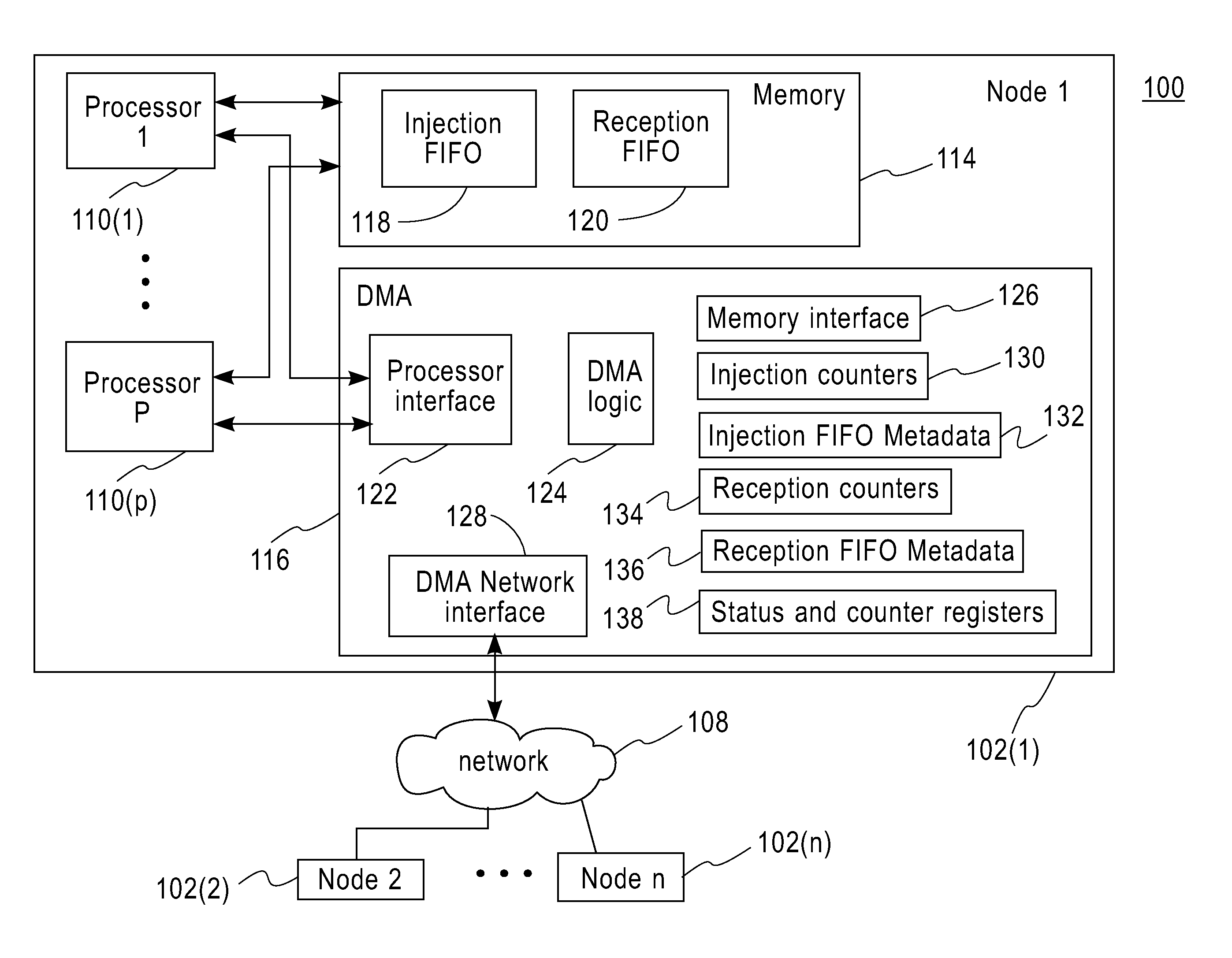Message passing with a limited number of DMA byte counters
- Summary
- Abstract
- Description
- Claims
- Application Information
AI Technical Summary
Benefits of technology
Problems solved by technology
Method used
Image
Examples
first embodiment
[0042]In a first embodiment or scheme, the invention comprises a simple rendezvous protocol transfer method or scheme that controls the MPI operating in the local application to perform the transfer at a compute node, as highlighted in handshaking steps of FIG. 2. Based on the novel scheme, an application running at a compute node manages the counters in such a way that a counter is either shared or exclusive. A shared counter tracks the progress of many messages. For example, a shared counter would only hit zero when all those messages have been sent. An exclusive counter is used to track the progress of only one message in the instant embodiment, but its operation includes tracking both the sending of the RTS (from the DMA at the source compute node) and the sending of the application's data. Only one descriptor is required for the RTS, which RTS descriptor indicates to the receiving DMA (at the target compute node) that it must be deterministically routed.
[0043]With MPI ordering ...
second embodiment
[0048]In a second embodiment or scheme, the invention comprises a simple resource management with shared counters scheme, wherein both the sender (source) or receiver (target) computes nodes have no available counters at a time in which several messages are being sent and received. This second scheme or embodiment efficiently transfers by reserving a shared injection counter that is then shared by all the remaining messages between the particular sender (source node) or the receiver (target node), the handshaking for which is highlighted in in FIG. 3. The remaining counters are referred to as exclusive counters that are not shared.
[0049]More particularly with respect to FIG. 3 and the second scheme, a sender (source) has no available exclusive injection counters, but the receiving (target) side has an exclusive counter, the sender uses the receiver's exclusive counter as a shared counter to send the RTS with deterministic routing. The RTS includes the identification of the source bu...
third embodiment
[0053]In a third embodiment or scheme, the invention comprises a simple rendezvous protocol that uses exclusive injection counters and shared reception counters in two separate cases, as highlighted by the handshaking shown in FIGS. 4 and 5 herein. The sender compute node allocates an exclusive counter and sends an RTS packet with a source buffer address, and size of the message to be sent. The RTS packet includes information for an acknowledgement, such as described with respect to the second scheme (FIG. 3) to include a sequence number, or an address for a direct put. The sent RTS packet must also include the last byte of the message that is being sent. The receiver compute node uses a shared overflow reception counter (located therein), and posts a remote get using a shared injection counter.
[0054]The cases here are notifying receiver of completion by polling the last byte of the message or two descriptors in the remote get. The first one will send the data and the second one wil...
PUM
 Login to View More
Login to View More Abstract
Description
Claims
Application Information
 Login to View More
Login to View More - R&D
- Intellectual Property
- Life Sciences
- Materials
- Tech Scout
- Unparalleled Data Quality
- Higher Quality Content
- 60% Fewer Hallucinations
Browse by: Latest US Patents, China's latest patents, Technical Efficacy Thesaurus, Application Domain, Technology Topic, Popular Technical Reports.
© 2025 PatSnap. All rights reserved.Legal|Privacy policy|Modern Slavery Act Transparency Statement|Sitemap|About US| Contact US: help@patsnap.com



